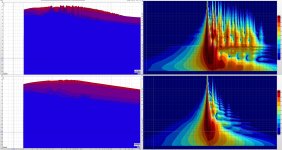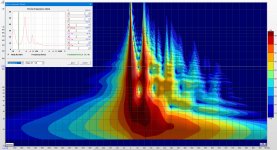Anyone know how to fix my results from when I import the IR from Vituix? The spl is off and it skews the decay/spectrogram results somewhat.
You can now import directly from HR into REW. I'm not sure when this capability developed. However, REW will now import IR.txt files as well as IR.wav files and HR eports IR.way. You don't need to go through Vituix anymore, if you ever did. And yes, I do recall who once suggested that.
No, you can only do this without Fill material! To include fill material you must do otherwise as I suggest.You can now import directly from HR into REW
A Linkwitz transform is about changing the Q of the rolloff slope in a closed box, a vented box has a 24dB rolloff rate so some other EQ or slope would be needed to match a sealed to vented.
Mark was it an actual LT or just PEQ? I can see the confusion.
Hi Fluid,
It was an actual biquad LT made with minDSP's spreadsheet and loaded into an OpenDRC.
I realize the LT is the math that changes effective F and Q,
but in my relentless need to characterize everything down to root level basics,
I kinda see it as mostly out-of-band shelving.
Hey, didn't i get in trouble recently for such oversimplifying in the IIR/FIR thread. ??? 😱 LOL
Anyway, below are some old measurements of the 18n862 in the vented and sealed boxes.
Green is the sealed with LT in place, along with 3PEQs
Blue is vented, notes say it too had 3 PEQs .
I can see I missed some apples to apples with freq response..as sealed doesn't roll-off as fast on the bottom as the vented.
And why I had a low pass in place for the sealed and not for the vented I dunno. Guess cause all I cared about was how the bottom ends compared.
The top box says Phase, but it should read Group Delay. Smaart has needed to fix that when toggling from phase view, ..for years..
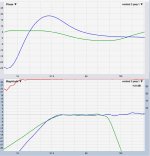
Linkwitz Transforma what? Low shelf? Just tell us what the filter settings are.
The top box says Phase, but it should read Group Delay. Smaart has needed to fix that when toggling from phase view, ..for years..
Negative group delay? Im pretty sure the vented group delay should rise not fall if there is no additional filtering applied
Last edited:
A few, for starters:I'm well aware of the argument "Sealed better than ported." And not just for subs. In the modern era of nearly unlimited wattage available, my question is: "Why would anyone want to do anything besides sealed?" Is there any claimed benefit other than improved sensitivity?
1) Better extension without EQ, which is great if you don't have EQ.
2) Because of the "free" output from the port, you reduce power requirements, excursion, and distortion.
"free" Nothings free in this town....Disortion of one kind goes away and an incresase in distortion of another shows up....Time based distortion, aka group delay and decay. I'm not saying you care...I'm just pointing out it ain't free.
No, you can only do this without Fill material! To include fill material you must do otherwise as I suggest.
Only for MTLs and such because HR doesn't show the IR in the wizard. Are you still focused on those?
Negative group delay? Im pretty sure the vented group delay should rise not fall if there is no additional filtering applied
The negative delay on the sealed says the timing reference Smaart choose was off a little. That's what I get for having the low-pass filter in place....that gave nothing concrete to time to.
It's always a bit dismaying, seeing the timing variations from our software as they try to determine sub timing. By variations I mean repeated back to back measurements. Just not enough data to work with, given linear FFTs.
I recently did a shootout, REW vs Smaart vs Systune to compare the spread of timing results from a sub lowpassed at 100Hz.
Without any higher freq content to time to, to build math off of, they all of course gave a distribution of timings.. REW had the most trouble.
But I wouldn't fully trust any of them when used on subs alone, without a fair amount of averaging
Here's another picture of the Group Delay with some smoothing removed.
Any data below 20Hz on the vented I would be suspicious of...not enough response to provide good coherence/confidence.
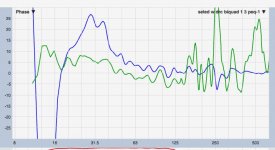
Only for MTLs and such because HR doesn't show the IR in the wizard. Are you still focused on those?
I ruled them out because I couldn't model the decay...and now that I can see it. I'm still building a sealed. It is interesting to see how well behaved a TL is with dampening. Heres a 289ish liter MLTL moderately stuffed (100/100) and unstuffed.
I'd say that only one of those is a well behaved vented cabinet.
Attachments
Here is a MLTL that I was so confused about because at the time I was trying to judge how resonant my designs were based off of impedance readings, and though there is a connection, the two systems are not one, in reference to dampening driver vs dampening the enclosure. Here I have dampened the front portion (little under 1/2) of the line, so much, that it has dampened the driver significantly. The impedance shows a peak of ~50ohms and for this 18" and that sensitivity would be awesome if it weren't for the fact that the rest of the line is completely empty.
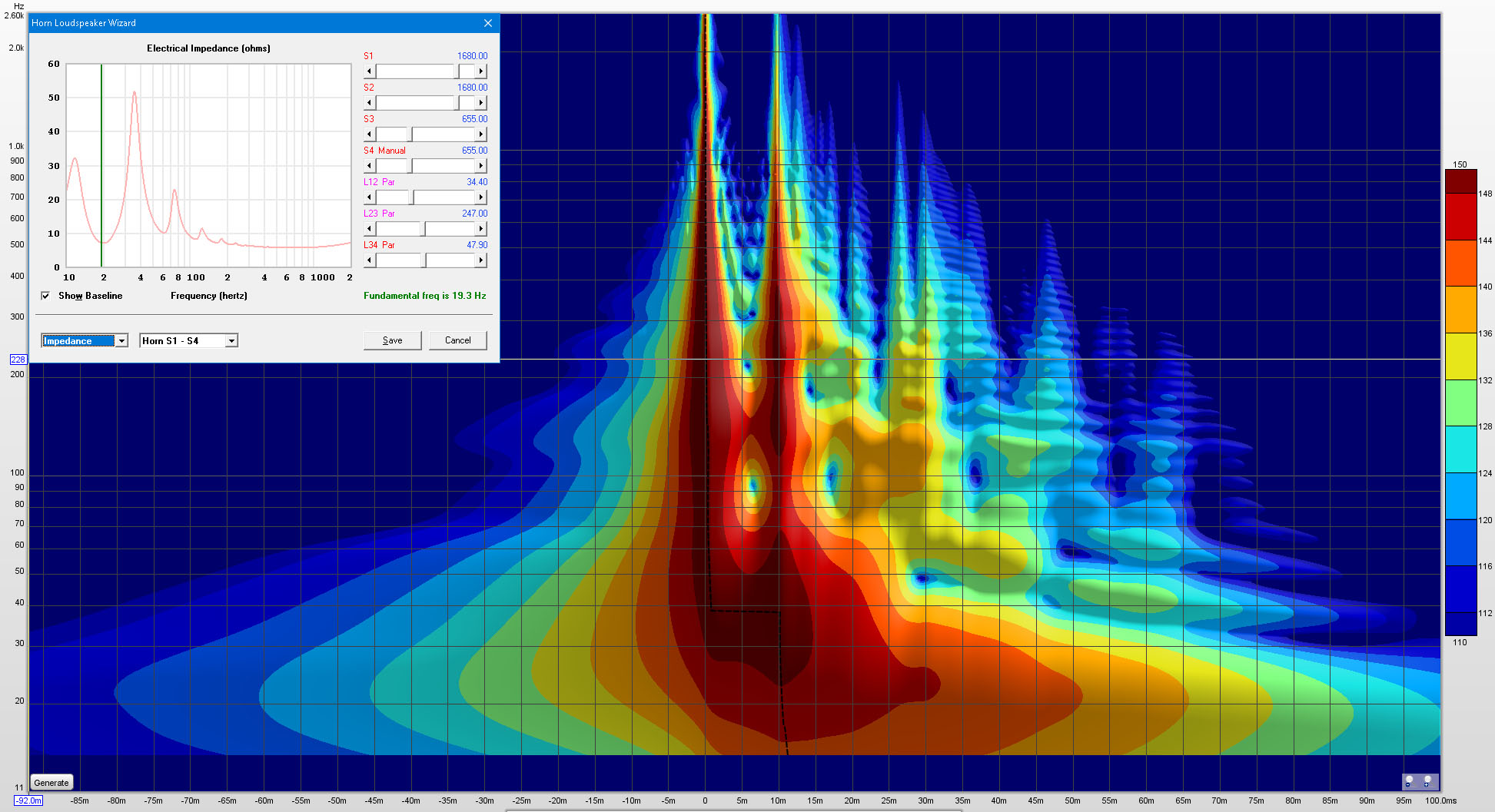
Attachments
Last edited:
You're right, I should've said "non-linear" distortion to be specific."free" Nothings free in this town....Disortion of one kind goes away and an incresase in distortion of another shows up....Time based distortion, aka group delay and decay. I'm not saying you care...I'm just pointing out it ain't free.
Am I misunderstanding something, or are you calling MLTLs vented?I ruled them out because I couldn't model the decay...and now that I can see it. I'm still building a sealed. It is interesting to see how well behaved a TL is with dampening. Heres a 289ish liter MLTL moderately stuffed (100/100) and unstuffed.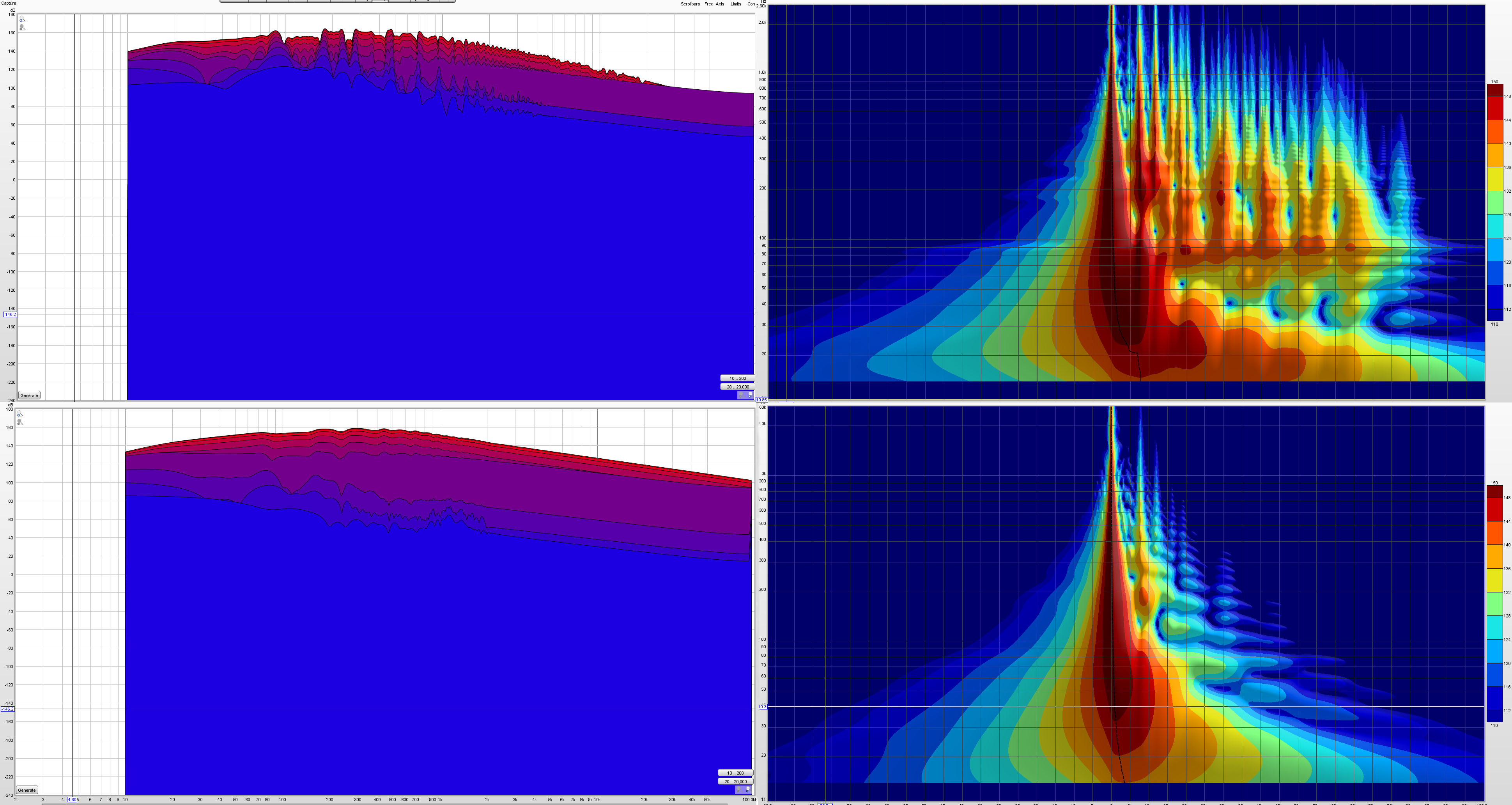
I'd say that only one of those is a well behaved vented cabinet.
What about back-loaded horns? Tapped horns? Aperiodic enclosures?A MLTL is a vented alignment.
Vent City, Truth be told I've adapted to calling everything a horn...cause I'm crazy like that.
If you really believe that this is an issue and you seem to have decided on a sealed alignment then when it is finished make a passive conjugate network for it and remove the peak from the impedance entirely.Heres a quote from a Mastering Studio designer
Oh wow "decay is linear and homogenous (as little variations as possible between octaves)" Oh really, big surprise there lol. An even spectral Decay? So should I put the resonant peak (huge increase in spectral decay centered around one area) of my driver/enclosure in the middle of my passband anyway oooorrrrrrr.........
Ha Ha, I had a feeling it was that 😉Hi Fluid,
It was an actual biquad LT made with minDSP's spreadsheet and loaded into an OpenDRC.
I realize the LT is the math that changes effective F and Q,
but in my relentless need to characterize everything down to root level basics,
I kinda see it as mostly out-of-band shelving.
Hey, didn't i get in trouble recently for such oversimplifying in the IIR/FIR thread. ??? 😱 LOL
It is out of band shelving with a notch, but what it does is quite specific.
That was my point you compared matched magnitudes above rolloff, to compare sealed to vented as regards group delay you need to match the rolloff slope, a 12dB filter at about 30Hz would probably get close.Anyway, below are some old measurements of the 18n862 in the vented and sealed boxes.
I can see I missed some apples to apples with freq response..as sealed doesn't roll-off as fast on the bottom as the vented.
And why I had a low pass in place for the sealed and not for the vented I dunno. Guess cause all I cared about was how the bottom ends compared.
The negative delay on the sealed says the timing reference Smaart choose was off a little. That's what I get for having the low-pass filter in place....that gave nothing concrete to time to.
I've never seen any simulation where the group delay on the low end is lower than above that. In your case It actually dips below the fairly steady level at around 200Hz. I don't think this is what group delay does. As I've said before, I think it should rise, not fall. The graph is probably not alles "group delay" for a reason 😉 So then what the hell is it?
- Home
- Loudspeakers
- Multi-Way
- The proper way to tune a vented design for SQ.
